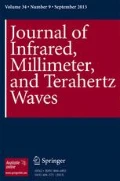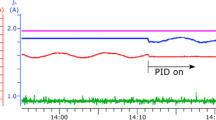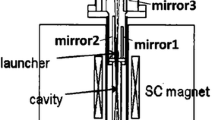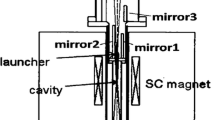Abstract
In this paper we present some initial results from a conceptual design study focused on the development of a novel frequency tunable gyrotron for nuclear magnetic resonance (NMR) spectroscopy with signal enhancement based on the utilization of high field radiation and dynamic nuclear polarization (DNP) technique. The first variants of both the electron optical system and the resonant cavity which have been designed aiming continuous frequency tunability in a broad frequency band are presented and discussed. The selected method for frequency tunability is based on the excitation of higher order axial modes and smooth transition between them. It was selected after a critical examination of the known theoretical and practical results related to the frequency control in gyrotrons. It is believed that the current conceptual design is an appropriate basis for development of the next (optimized) design which will include also a detailed design of other components (mode converter, output window etc.) and magnetic circuit (superconducting magnet and supplementary solenoids) as well as for the overall mechanical design and fabrication of the prospective gyrotron.
Similar content being viewed by others
References
[1] Macomber R.S. A Complete Introduction to Modern NMR Spectroscopy, John Willey and Sons, (1998).
[2] Abragam A. The principles of Nuclear Magnetism, Clarendon Press, Oxford, UK (1961).
[3] Abragam A., Goldman M. Nuclear Magnetism: Order and Disorder, Clarendon Press, Oxford, UK (1982).
[4] “High field NMR: A Baseline Study” prepared by the committee for “High Field NMR: A New Millennium Resource (More information on this study can be found at http://nmr.magnet.fsu.edu/resources/archive/nmrstudy/
[5] Wuthrich K. NMR of Proteins and Nuclear Acids, Willey (1994).
[6] Cavanagh J. et al. Protein NMR Spectroscopy — Principles and Practice, Academic Press (1996).
[7] Becerra L.R., Gerfen G.J., Temkin R.J., Singel D.J. and Grifin R.G. Dynamic Nuclear Polarization with a Cyclotron Resonance Maser at 5 T. Phys. Rev. Lett., 71 (1993) 3561–3564.
[8] Weis V., Benati M., Rosay M., Bryant J.A. and Griffin R.G. High-Field DNP and ENDOR with a Novel Multiple-Frequency Resonance Structure. J. of Magnetic Resonance, 140 (1999) 293–299.
[9] Bajaj V.S., Farrar C.T., Hornstein M.K., Mastovski I., Vieregg J., Bryant J., Elena B., Kreischer K.E., Temkin R.J. and Griffin R.G. Dynamic Nuclear Polarization at 9 T using a novel 250 GHz gyrotron microwave source. J. of Magnetic Resonance, 160 (2003) 85–90.
[10] Hornstein M.K., Bajaj V.S., Griffin R.G., Kreischer K.E., Mastovsky I., Shapiro M.A., Sirigiri J.R., and Temkin R.J. Second Harmonic Operation at 460 GHz and Broadband Continuous Frequency Tuning of a Gyrotron Oscillator. IEEE Trans. Electr. Devices, 52 (2005) 798–807.
[11] Woskov P.P., Bajaj V.S., Hornstein M.K., Temkin R.J. and Griffin R.J. Corrugated Waveguide and Directional Coupler for CW 250 GHz DNP Experiments. IEEE Trans. MTT, 53, (2005) 2363–2369.
[12] Sabchevski S., Mladenov G., Idehara T. Modeling and Simulation of Magnetron Injection Guns for Submillimeter Wave Gyrotrons. Int. Journal of Infrared and Millimeter Waves, 20 (1999) 1019–1035.
[13] Sabchevski S., Idehara T., Glyavin M., Ogawa I., Mitsudo S. Modelling and simulation of gyrotrons. Vacuum, 77 (2005) 519–525.
[14] Nusinovich G.S. Introduction to the physics of gyrotrons, John Hopkins University Press, Baltimore and London (2004).
[15] Bratman V.L., Fedotov A.E. and Idehara T. Temporal dynamics of mode interaction in submillimeter wave second-harmonic gyrotron. Int. Journal of Infrared and Millimeter Waves, 22 (2001) 1409–1420.
[16] Nusinovich G.S., Sinitsin O.V., Velikovich L., Yeddulla M., Antonsen T.M., Vlasov A.N., Cauffman S.R. and Felch K. Startup Scenarious in High-Power Gyrotrons. IEEE Trans. Plasma Sci., 32 (2004) 841–852.
[17] Idehara T., Tatsukawa T., Ogawa I., Mori T, Tanabe H. and Wada S. Competition between fundamental and second-harmonic operations in a submillimeter wave gyrotron. Appl. Phys. Lett. 58 (1991) 1594–1596.
[18] Brand G.F., Idehara T., Tatsukawa T., Ogawa I. Mode competition in a high harmonic gyrotron. Int. J. Electronics, 72 (1992) 745–758.
[19] Idehara T., Shimizu Y. Mode cooperation in a submillimeter wave gyrotron. Phys. Plasmas, 1 (1994) 3145–3147.
[20] Idehara T., Mitsudo S., Pereyaslavets M., Shimizu Y. and Ogawa I. Mode cooperation in a submillimeter wave FU Series gyrotron. Int. Journal of Infrared and Millimeter Waves, 20 (1999) 1249–1270.
[21] Idehara t., Shimizu Y., Makino S., Ichikawa K., Tatsukawa, Ogawa I., Brand G.F. Rapid frequency step-switching of a submillimeter wave gyrotron by modulation. Phys. Plasmas, 1 (1994) 1774–1776.
[22] Idehara T., Shimizu Y., Ogawa I., Tatsukawa T. and Brand G.F. Rapid frequency step-switching in submillimeter wave gyrotrons (Gyrotrons FU III and FU IV). Phys. Plasmas, 6 (1999) 2613–2617.
[23] G.F. Brand, Tunable Gyrotrons. Chapter in Infrared and Millimeter Waves vol. 14 (ed. K.J. Button, Academic Press, New York, 1985) 371–408.
[24] Brand G.F., Chen Z., Douglas N.G., Gross M., Ma J.Y.L. and L.C. Robinson, A tunable millimeter-submillimeter gyrotron. Int. J. Electronics, 57 (1984) 863–870.
[25] Kreischer K.E., Danly B.G., Woskoboinikow P., Mulligan W.J. and Temkin R.J. Frequency pulling and bandwidth measurements of a 140 GHz pulsed gyrotron. Int. J. Electronics, 57 (1984) 851–862.
[26] Kariya T., Saito T., Kiwamoto Y., Gotoh H. and Miyoshi S. Observation of Frequency Pulling Effect in Gyrotron. Jpn. J. Appl. Phys., 25 (1986) 654–655.
[27] Jones R.M. and Alcock M.W. The power transfer and frequency detuning in a gyrotron. Int. J. Electronics, 57 (1984) 901–914.
[28] Jones R.M. and Linsay P.A. Measurement of frequency shift in a gyrotron oscillator. Int. J. Electronics, 61 (1986) 937–951.
[29] Zasypkin E.V. Electron frequency detuning in gyrotrons. Radiotekhnika I Elektronika (in Russian, translation: Soviet J. Commun. Technol., Electron), 32 (1987) 2599–2605.
[30] Antakov I.I., Zasypkin E.V., and Sokolov E.V. Electron tuning of frequency in gyrotrons. Int. Journal of Infrared and Millimeter Waves, 14 (1993) 1001–1015.
[31] Dumbrajs O., Nusinovich G. Theory of a frequency-step-tunable gyrotron for optimum plasma ECRH.- IEEE Trans. Plasma Sci., 20 (1992) 452–457.
[32] Idehara T., Pereyaslavets M., Nishida, and Yoshida K. Frequency Modulation in a Submillimeter-Wave Gyrotron.- Phys. Rev. Lett. 81 (1998) 1973–1976.
[33] Pereyaslavets M., Idehara T., Nishida N., Yoshida K., Yoshida K., and Ogawa I. Simulation and Measurement of Frequency Modulation in Submillimeter-Wave Gyrotron. IEEE Trans. Plasma Sci., 27 (1999) 363–366.
[34] Dumbrajs O., Piosczyk B. Resonator for frequency step tunable gyrotron. Int. J. Electronics, 68 (199) 885–890.
[35] Zasypkin E.V., Moiseev M.A., and Nemirovskaya L.L. Expansion of a frequency tuning band ina gyrotron with coupled cavities. Int. J. Electronics, 85 (1998) 207–216.
[36] Brand G.F., Chen Z., Douglas N.G., Gross M., Ma J.Y.L., and Robinson L.C. A tunable millimeter-submillimetre gyrotron. Int. J. Electronics, 57 (1984) 863–870.
[37] Ching E.S.C., Leung P.T., A. Maassen van den Brink, Suen W.M., Tong S.S., and Young K. Quasinormal-mode expansion for waves in open systems. Rev. Modern Phys., 70 (1998) 1545–1554.
[38] Vlasov S.N., Zhislin G.M., Orlova I.M., Petelin M.I., Rogacheva G.G. Open resonators in the form of waveguides of changeable cross-section. Izv. Vishih Uchebn. Zaved.— Radiofizika, 12 (1969) 1236–1244 (in Russian).
[39] Fliflet A.W., Read M.E. Use of weakly irregular waveguide theory to calculate eigenfrequences, Q values, and RF field functions for gyrotron oscillators. Int. J. Electronics, 51 (1981) 475–484.
[40] Chu K.R., Kou C.S., Chen J.M., Tsai Y.C., Cheng C, Bor S.S., and Chang L.H. Spectral domain analysis of open cavities. Int. Journal of Infrared and Millimeter Waves, 13 (1992) 1571–1598.
[41] Hung C.L., Tsai Y.C., and Chu K.R. A Study of Open-End Cavities by the Field-Energy Method. IEEE Trans. Plasma Sci., 26 (1998) 931–939.
[42] Jansen E., Schunemann K. Network-theoretical model of the gyrotron oscillator. Part I: Empty cavity oscillation modes. Int. Journal of Infrared and Millimeter Waves, 12 (1991) 1271–1308.
[43] Xu A.-H., Zhou L.-Z. and Xu Ch.-H. A method for the synthesis of microwave open resonators. Int. J. Electronics, 57 (1984) 887–899.
[44] Bratman V.L., Moiseev M.A., Petelin M.I., and Erm R.R. Theory of gyrotron with a non-fixed structure of the high-frequency field. Radiophys. Quant. Electron., 16 (1973) 474–480.
[45] Fliflet A.W., Read M.E., Chu K.R, and Seeley R. A self-consistent field theory for gyrotron oscillators: application to a low Q gyromonotron. Int. J. Electronics, 53 (1982) 505–521.
[46] Botton M., Antonsen T., Levush B., Nguyen K., and Vlasov A. MAGY: A time-dependent code for simulation of slow and fast microwave sources. IEEE Trans. Plasma Sci., 26 (1998) 882–892.
[47] Chang T.H., Pao K.F/, Chen S.H., and Chu K.R. Self-consistent effects on the starting current of gyrotron oscillators. Int. Journal of Infrared and Millimeter Waves, 24 (2003) 1415–1420.
Author information
Authors and Affiliations
Rights and permissions
About this article
Cite this article
Sabchevski, S., Idehara, T., Mitsudo, S. et al. Conceptual Design Study of a Novel Gyrotron for NMR/DNP Spectroscopy. Int J Infrared Milli Waves 26, 1241–1264 (2005). https://doi.org/10.1007/s10762-005-7601-x
Received:
Published:
Issue Date:
DOI: https://doi.org/10.1007/s10762-005-7601-x




